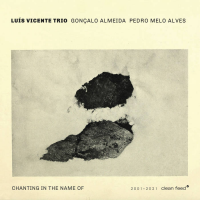Home » Jazz Articles » Live Review » Ethno Port 2021
Ethno Port 2021

Courtesy Maciej Kaczyński
Zamek Culture Centre
Poznań, Poland
September 3-5, 2021
The 2021 Ethno Port was much closer to the festival's accustomed scale, although still with a limited audience size. There were also no freebie outdoor performances in front of the Zamek castle-palace, although this was due to the ongoing reconstruction of its frontal area. Previously, the car park has been covered with artificial grass for the Ethno Port weekend, so it was dispiriting to have this 'willing illusion' dispersed in 2021. Perhaps the 2022 edition can make use of the garden-park area behind Zamek?
Ethno Port's great achievement was the return of artists from other lands, following 2020's all-Polish selection. This happened in radical fashion, with no cancellations and only one travel delay. This year, there was only a tiny sprinkle of indigenous Polish folk talent. Usually, the local artists are an important element, but this time, the festival organisers were making a targeted effort as a response to the 2020 international restrictions.
The gigs mostly took place in the indoor Grand Hall and the covered courtyard of Zamek, with late night DJ sessions in the Meskalina bar and restaurant. This old German-built castle (technically a palace) houses multiple venues, exhibition spaces, a cinema, bookshop, several cafés, and the Blue Note Jazz Club. The Nazis were ejected decades ago, and a future of complete cultural primacy evolved. Ethno Port is dedicated to folk-rooted, traditional ethnic music from all quarters, also open to fusion hybrids, but usually those that possess a sharper bite.
The opening Friday run brought acts in from Finland, Syria and France. Maija Kauhanen plays the Finnish traditional instrument, the kantele, which symbolises the essence of the country's folk heritage. This box zither has cousins across the Baltic region, with different names in each land. Kauhanen also surrounded herself with a large percussion array, and sang songs for much of her set, demonstrating equal proficiency in all of these areas. Coupled with amplification effects, she emanated a big-reverb sound, becoming a virtual one-woman orchestra. Kauhanen's vocal range curved high, but her best results came when she swooped lower, towards incantation, with a yodelling effect. The bass strings on her kantele were also impressively resonant, as this customised instrument was fashioned by herself and her father. Often, there was a hard hi-hat and bass drum beat to strengthen the songs, while Kauhanen would also introduce surprising innovations, such as playing slide kantele with a metal mug. She offered a pair of traditional polkas, detailed with a small manicuring stick, and then shocked agan, by turning the subject of one song around to graphically illustrate a tale of domestic violence involving an axe. This was vocally fraught, to suit its subject matter. Kauhanen maintained strong levels of folkloric accuracy, alongside her own form-bending innovations, allowing influences from the realms of rock drama and introverted improvisation.
Waed Bouhassoun (vocals/oud) led a trio with Emine Bostanci (kemenche) and Neset Kutas (frame drum, percussion), opening her set with a pair of solo songs. Her playing partners entered soon, concentrating on sufi sounds, but working their way towards mainline traditional Syrian tunes, the latter invariably being shorter in length, snappier in style. The leaders of this first night, and quite possibly the entire festival were Super Parquet, from the Auvergne region in France. Hardcore vocals, banjo and pipes met two banks of electronics, subjecting folksong to heavy repetitions, japing over a bedrock of behemoth beats and basslines. They were reminiscent of La Tène, from Geneva, another outfit who take cabrette-piping, harmonium and hurdy gurdy on a roughshod ride through the systems music canyon, although Super Parquet are kings of the electronic dancefloor, rather than being gritty minimalist avant gardists. This Auvergne crew still displayed a bruised, and bruising form of folk, operating on an extremely aggressive, atonal level, moulded from prime matter for electronics-bolstered enlargement. Indeed, the Super Parquet cabrette dude, Louis Jacques, has actually guested with La Tène. This set incrementally built up an extremely compulsive dancing-sway, which spread throughout some of the audience, prompting contagious pockets of dervish abandonment. Super Parquet should definitely tour more in 2022.
The middle Saturday opened with a talk session featuring the French/Swiss/Indian trio Masar, the first of three very successful meetings with musicians over the weekend. The other sessions involved Maija Kauhanen, and the English/Italian duo of Justin Adams and Mauro Durante. All of these had sets forthcoming, but it was enlightening to hear them discuss, very informally, and with quite small groupings, their attitudes and experiences, as well as delivering short outbreaks of live music. These were amongst the best discussion gatherings witnessed by your scribe, with their intimate clusters of seating and the lack of need for microphone amplification.
The actual performances began at 4pm with the accordionist Yegor Zabelov, from Belarus. He shares a similar sonic outlook with Kimmo Pohjanen from Finland, savouring the instrument's capacity for percussive staccato extremity, or slow, drawn-out wheezing, concentrating on bellows quality, and stroking out the innate aerating qualities of the accordion. Zabelov liked to make sudden pulls, opening to full span, operating in an orchestral fashion. He coaxed out bass rumbles, via microphone placement, sounding like a didgeridoo playing minimalist passages. Zabelov licked out overtones, climaxing by adding his own vocal accompaniment, sometimes melodic humming, but just as often shouting or screaming. Zabelov still sounded like a folkster, but he'd be welcome, and has indeed appeared at more experimental music festivals.
Masar features Amine Mraihi (oud), Sylvain Barou (flutes) and Prabhu Edouard (tabla). This trio could be quite comfortable nestling in the catalogue of the ECM record label, with a sound reminiscent of the 1987 Zakir Hussain album Making Music. The oud is electrified, the bansuri Indian flute is Barou's key choice, and the compositional palette lies frequently within the borders of ethno-prog-jazz. When Mraihi chooses, his oud riffs can possess great power, but he can switch to a subtle softness, when desired. This trio has a bold mixture of electric and acoustic sensibilities, grasping both choices with ease. Barou switched to the Armenian duduk, and then a cyclic oud-riff prompted a sky-fire flute solo. Masar provided the strongest amount of jazz fusion during the weekend, as other acts had already pushed towards electronica or pop music.
Impressive though Maija Kauhanen's talk presentation and solo set were, her involvement in the full-scale band Okra Playground was not so appealing. This featured doubled kanteles in keytar roles, along with electric violin, accordion, keyboards, bass, drums and electro-percussion, with shared vocals. The whole sonic assault was bombastic in the Eurovision fashion, still strong on folk detail, but presented with no subtlety whatsoever. It involved virtuoso playing, delivered in a clumsy, desensitised manner, like a hammer blow to the ears, dynamic range lost for the (lengthy) duration. The songs did improve around the middle section, for a while, when the jouhikko traditional lyre appeared, and the vocals found a more jarring harmonic clash, but it wasn't long before the anthemic stompers returned. The fiddle and accordion took the best solos.
This made the soon-following set by Trio Da Kali and the Sepia Ensemble sound even more organically expressive, radically changing the atmosphere for their late night outdoor collaboration in the courtyard. The trio had been delayed for a day, stuck at Istanbul Airport, missing their talk presentation but landing in time for their gig. The Polish string quartet Sepia expanded the regular Kali core of vocals, balafon and bass ngoni, with their classic Malian manner cloaked by a twinkling (though sometimes brooding) string softness. Sepia also added a swinging, swaying motion, something that is already found in Malian music, but here intensified. The trio were visibly excited by this extension of their songs. Towards the close, Sepia introduced some spikier sonics, strange dissonances that could have arrived from either Bernard Herrmann or Astor Piazzolla, strafing, sweeping, flicking and swiping.
The Sunday selection was equally varied, in terms of nationalities, styles, and levels of introversion or extroversion. Zawierucha are a Polish group who are ripe for export, uncompromising and danceable. Piotr Zgorzelski leads from a standing-up position, even though he plays the cello. Strictly speaking, this appears to be the basy, cello-sized, but a Polish folk bass instrument. Zgorzelski spent much of the gig dancing as well as playing, his partner mostly being his basy instrument, held in his arms when being bowed. He also sang songs and explained to the audience, while a call-out-leader stepped down onto the audience-floor to guide threads of circulating dancers. Waltzes and polkas ensued, with the odd sorrowful dirge. There was a kind of exuberant misery to the fleeter numbers. The highly impressive lead violinists (Marcin Drabik, Kacper Malisz) played in keening unison, each with solo turns, accenting and flourishing, underpinned by a sharp drum attack on a tiny hi-hat and small snare. Mazurkas sprang from very abstract introductions, coupled with very subtle muted-cymbal strikes.
The Cimbalom Brothers proved that unchained exuberance could be a facilitator for an exciting success. Like Okra Playground, these Hungarians were excessive in their drive, but this double-cimbalom quartet also possessed a gritty energy. It was a prog-folk storming, assisted by guitar and upright bass, although these last two instruments took side-seats to the drag-racer cimbaloms. The duo of Unger and Lisztes also presented their delicate side during the occasional pauses in the flow, allowing each other some solo space. The bass plodded emphatically, lending power, but the guitar was a less prominent audio filler. Yes, they played "Hava Nagila," as popularised by Dick Dale, as well as a rush of Romanian and Bulgarian tunes, even some actual Hungarian czardas, showering and glittering from the hammered strings. There was Django Reinhardt's "Minor Swing," and thence to Macedonia for some 9/8 rhythms..!
The weekend's last two performances took the mood to the inward-looking zone. The Sero presented the formal form of South Korean tradition, at least in the eyes of comparatively sloppy Westerners. The ritual dignity of the original compositions held great authority, although still possessing a few shiny popular music qualities in the presentation. The traditional gayageum (plucked zither) and ajaeng (of koto size) instruments dominated, alongside the voices, with gong percussion also present. Straight afterwards, Justin Adams and Mauro Durante took over the courtyard, making their duo music fill the space with its implied rock'n'roll drive. Adams provided the American blues, and the Saharan blues, with his earthy guitar riffing, while Durante boomed articulately on his Italian folk frame drum, side-stepping North African traditions, but almost there, across the Mediterranean. Both Adams and Durante had heartfelt vocals to add, completely different in their qualities and backgrounds, but united in passion for ritualistic expression, combining tradition with self-penned songs. Some of the numbers sounded very Canzoniere Grecanico Salentino (the group that Durante leads), while others had Adams as the primary Afro-blues force, moving closely towards Led Zeppelin, after his years playing with Robert Plant.
Could 2022 be the year where Ethno Port returns to its fully-firing self, last witnessed in 2019? All of our folkish fingers are fully crossed!
Tags
Live Review
Martin Longley
Poland
Poznan
Justin Adams
Kimmo Pohjanen
Zakir Hussain
Bernard Herrmann
Astor Piazzolla
Dick Dale
Robert Plant
PREVIOUS / NEXT
Support All About Jazz
 All About Jazz has been a pillar of jazz since 1995, championing it as an art form and, more importantly, supporting the musicians who make it. Our enduring commitment has made "AAJ" one of the most culturally important websites of its kind, read by hundreds of thousands of fans, musicians and industry figures every month.
All About Jazz has been a pillar of jazz since 1995, championing it as an art form and, more importantly, supporting the musicians who make it. Our enduring commitment has made "AAJ" one of the most culturally important websites of its kind, read by hundreds of thousands of fans, musicians and industry figures every month.





















